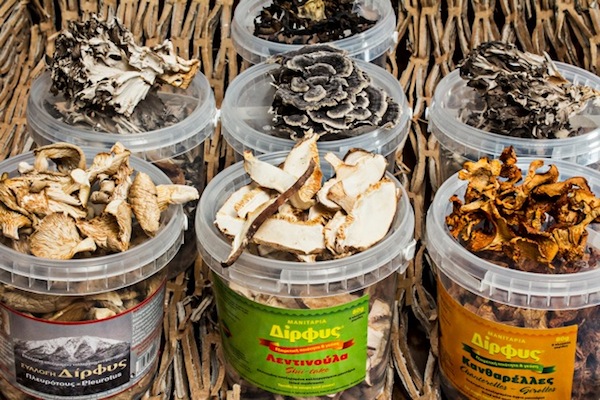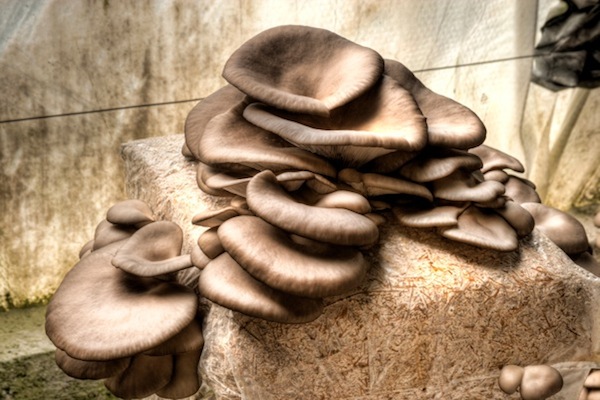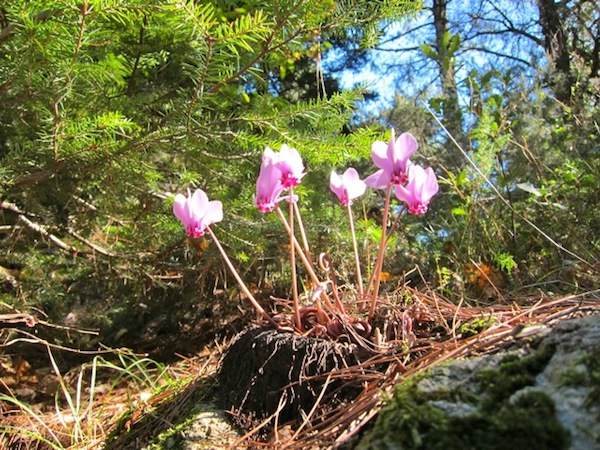Everything’s Coming Up Mushrooms—In Evia, Greece
Eating Well Is The Best Revenge
By Diana Farr Louis

“When we got to the cultivation ‘hangars,’ perhaps a kilometer away, the aroma of mushrooms in the air outside was more than tempting—and there was no garlic and parsley frying with them. This was just their own perfume, and I felt it might make a nice change from the Eau d’Issay I often wear.” Diana Farr Louis
ATHENS Greece—(Weekly Hubris)—10/29/2012—Lefteris Lahouvaris and Thanassis Mastroyiannis have a passion for mushrooms. I guess you could call them “mycoholics” because even though their farm produces 500 kilos of fresh oyster mushrooms a day, their enthusiasm bubbles over when they talk about them. And the demands made by these fast-growing fungi compare with those of a swollen milk cow: if you don’t pick them exactly when they’re ready, they flop over and die. The two men haven’t had many days off since the farm opened in 2004.
Although I had talked to Lefteris, a mycologist with more than 20 years experience, several times on the phone and even written an article about the farm in 2009, I didn’t go on a magical mushroom tour until last Saturday.
Central Evia is a pastoral region, full of streams, gently yellowing trees, and thick firs in the ascending foothills of a bald mountain, Dirfys, which gives its name to the company (www.manitariadirfis.gr). Our first stop, on a visit that took us from finish to start, was the warehouse/packaging building near a village called Pissonas.
Lefteris, who is in his early forties, greeted us at the entrance to a large room where two women were removing bunches of pleurotus ostreatus from a large pile and placing them delicately in one-pound styrofoam containers. He explained the origin of the name: plevro (Greek) > pleuro (Latin) = side; and otus = ear; ostreatus; resembling an oyster.
Unlike button mushrooms, which grow best in beds of earth containing treated horse manure, these (and there are 45 types of pleurotus) like to grow on the sides of trees, in the way that ears stick out from the sides of our heads, and in shapes reminiscent of crustaceans.
Lefteris then he took us into the shop, a no-frills wall of shelves containing dozens of goodies to delight fungi fans: colorful boxes of dried morels, porcini, chanterelles, shiitake; mushroom powders for use in soups or for sprinkling; mushroom teas; strips of ganoderma, which looked a bit like brown band-aids and, though not edible, make excellent tisanes with healthful properties; essential oils; truffles—from the mountains of Thrace; and even mushroom beer.
Our eyes gleaming at the chance to buy these delicacies at wholesale prices, we listened to Lefteris summarize their medicinal uses and nutritional value, some of which information came as a surprise. Who knew that mushroom teas, depending on the variety, can boost the immune system, reduce blood sugar, lessen arthritic pain, and combat asthma—to mention just a few benefits? Or that dried mushrooms contain more than 20 percent protein, B vitamins, minerals such as magnesium, iron, phosphorus, microelements with antioxidant properties such as selenium, and dietary fiber?
Moreover, lignin-destroying enzymes, which enable pleurotus to break up old trees, also break up the cholesterol molecules in our own bodies. Up to now, I’ve been devouring them only because they’re so scrumptious.
Lefteris also cautioned, “Never bother with canned mushrooms. The processing destroys all their goodness.” (Not that such a thought would cross my mind.)
Before we left with our loot, I asked one of the young women at the packing counter, “Do you like mushrooms or does handling them all day ruin your appetite?”
“Not at all,” she smiled. “I love them, especially with cream in a sauce for pasta.”
When we got to the cultivation “hangars” perhaps a kilometer away, the aroma of mushrooms in the air outside was more than tempting—and there was no garlic and parsley frying with them. This was just their own perfume, and I felt it might make a nice change from the Eau d’Issay I often wear.
In this particular section, there were about seven hangars with mushrooms growing at different stages in plastic-wrapped bales of cellulose-rich straw and bran that make a perfect substrate or “nest” for the fungi. The straw, from the plain of Thessaly, Greece’s breadbasket, is pasteurized at another location and then injected with shroom “spawn” imported from France. It is pasteurized rather than sterilized in order to retain the helpful bacteria that promote the growth of the bacilli.

After the bales are inoculated, they remain in a darkened incubation room for 15 days, but when they’re taken into the lighted hangars that are kept cool and damp, holes are punched in the plastic and it takes only three days for the shrooms to burst forth. The more light, the faster the growth.
They proved amazingly photogenic and varied in size from about 1 inch to 10 inches, with 60 centimeters (almost 2 feet in width) the record.
The pasteurization plant, 7 kilometers away to reduce any danger of contamination from the huge piles of untreated straw waiting for crushing, was an impressive sight as well. Every Friday, 120 tons of material is lifted into an enormous tunnel, which is then sealed and left to “cook” for three days. Dirfis uses some 200,000 tons of straw every year to produce more than 350,000 blocks of ready-to-use substrate.
We were staggered at the amount. Greeks are notoriously fussy about mushrooms, associating wild ones with poisoning and cultivated ones with horse shit. But we must be witnessing a paradigm shift in attitudes because Dirfis also sells its inoculated substrate to other shroom farmers all over Greece. When Lefteris and Thanassis formed their company, there were only four such producers. Now there are 48, all but five “progeny” of Dirfis
What’s more, there’s no waste. The plastic covers can be recycled and the used straw makes a fantastic mulch and is sold cheaply to vegetable farmers. And if you’d like to grow your own, you can buy a packet for 7 euros that will keep you in shrooms for about five months.
Besides cultivating all those pleurotus as well as shiitake, Lefteris also roams the hills of Evia for wild mushrooms in the fall—only morels grow in spring. He took us on a steep walk beside a spring where they normally thrive, but the rains have been late this year so all we found were cyclamen.

Never mind; he sent us to a splendid taverna near an ebullient spring surrounded by a colony of vast plane trees. At the end of the road, in the middle of nowhere, it was also hosting a busload of Greek day-trippers, a possible downer. But Christos, the owner, sat us at a different level, away from the smoke and chatter, and fed us: grilled mushrooms, mushrooms fricassee with greens and a lemon sauce, three kinds of salad, spicy baked eggplant and pepper casserole, roast lamb, spitted pork, crisp fried potatoes, better than average wine, and two desserts (all for 11.50 euros a head!). As we ended our meal, the Greeks had started dancing.
For one whole day, our so-called “Economic Crisis” had been shoved into oblivion.
![]()
Recipe
At our organic farmers’ market in Kifissia, Athens, the pleurotus seller has an attractive come-on, a baking dish filled with more-ish shrooms cooked with garlic, olive oil, lemon, and parsley. Usually I stand there with toothpick poised and savor as many mouthfuls as is decent. It couldn’t be easier and it’s absolutely delicious.
For three people, I used half a packet of Dirfis pleurotus mushrooms, cut them into fairly small pieces, added a good handful of chopped garlic, another good handful of chopped parsley, and then tossed them in olive oil and lemon juice. I baked them in a medium oven for about 10 minutes, as instructed, and we wiped the platter clean.
![]()
Shroom photos courtesy Dirfis Mushrooms; cyclamen by Petros Ladas.


3 Comments
Olia Jacovides
You have succeeded in making me VERY hungry, once again ! I’m going straight out to buy some pleurotus mushrooms, which I’d forgotten about this summer…Before that, I used to cook them with potatoes, garlic and lemon in the oven – instead of meat or chicken. They were delicious ! So sorry I missed the trip, I had arranged to go to Monemvassia and Mani with 3 friends – that also turned out to be a wonderful journey, with perfect weather and the opportunity to taste some specialties from the Mani area and fresh fish…
di
mmmmmm – mushrooms – one of the few things I can still eat (and enjoy) – though NOT with garlic…….
The pictures are amazing!
di
x
diana
We missed you, Olia. Thanks to you and Di for the nice comments.